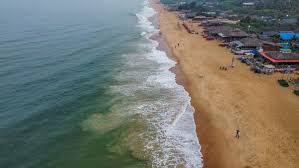A state that once valued simplicity and social cohesion now measures success by the square footage of its villas

In most parts of the world, a well-understood principle governs real-estate valuation: urban land costs more than rural land. Cities represent the centres of employment, infrastructure, and convenience, while rural settlements offer serenity at a fraction of the cost. The coastal villages of Anjuna, Siolim, and Vagator command prices that rival, and in some cases exceed, the premier addresses of metropolitan India. In these once sleepy settlements, luxury villas tagged as Indo-Portuguese masterpieces are sold for prices starting at five crores and escalating beyond ten crores. It raises an unavoidable question: for whom are these homes really meant?
The misfit of
market logic
In Panjim, Margao, or Vasco, commercial and residential properties follow a relatively predictable market trajectory. Office spaces, retail premises, and mid-range apartments are available to genuine businesses or middle-income households that generate steady revenue. But travelling 20 kilometres towards the coast makes the same rupee lose all meaning. There, modest plots of land are marketed at astronomical rates, justified by proximity to the beach and the romanticised label of heritage architecture. Developers use words such as “quaint”, “authentic”, and “exclusive” to sell villas that are detached from local affordability and from the Goan reality. The price tag of five to ten crores is not merely steep; it symbolises an economy that caters to outsiders while pricing out its own people.
A distortion of
demand
Economists might call it an anomaly of supply and demand, yet the Goan case is more complex. Supply is limited because land is finite and coastal regulation zones restrict expansion. Demand, however, is artificially inflated by speculative capital, much of it flowing from outside the state. For buyers from metros, the cost of a villa in Goa may seem reasonable compared with properties in Mumbai or Delhi. For Goans, whose median income seldom allows for a crore-level investment, the property ladder has been pulled up entirely. What remains is a two-tiered market: one for the wealthy transient resident, and another for the struggling local who can no longer afford to live where his ancestors farmed, fished, and built family homes.
The heritage premium
The sudden obsession with Indo-Portuguese aesthetics has become another instrument of inflation. Developers restore or replicate old Goan homes, infuse them with boutique interior décor, and stamp them with a heritage label that multiplies the price. Ironically, many such villas barely respect traditional architecture; they merely borrow its façade. The heritage narrative, once rooted in cultural continuity, has become a marketing ploy. Heritage itself has been commodified into a luxury aesthetic accessible only to those who have never known what it means to inherit a real Goan home.
It is telling that real estate in Panjim, despite being the state’s capital, remains relatively accessible to businesses and professionals. Commercial rentals are high but attainable, and retail activity continues to thrive. By contrast, the rural coastline has become an enclave of exclusion. The very landscapes that once symbolised simplicity and community now serve as gated sanctuaries for the ultra-rich.
From serenity
to speculation
The problem lies not merely in high prices but in what they signify. A home once represented stability, family, and rootedness; now it represents investment, status, and returns. The coastal belt has turned into a speculative playground where wealth seeks appreciation rather than habitation. Some properties remain locked for months, serving as occasional retreats rather than lived-in homes. Villages once vibrant with local life are now punctuated by silent villas, guarded gates, and imported cars. The very soul of Goan village life, its neighbourliness, festivals, and evening conversations, has been displaced by a market that values exclusivity over belonging.
The Monaco mirage
There is a tempting argument that Goa is evolving into the Monaco of India, a tax-friendly haven for high-net-worth individuals seeking leisure, privacy, and minimal scrutiny. Yet this analogy ignores the fragility of Goa’s infrastructure and social fabric. Monaco was designed as a financial enclave; Goa was not. The local economy, driven by tourism and small enterprise, cannot sustain a real-estate sector priced at international luxury levels. If the unchecked spiral continues, Goa risks becoming an island of privilege surrounded by an ocean of dispossession.
The cost of overvaluation is not measured merely in crores but in cultural erosion. When ancestral houses are sold to finance emigration, when villages lose their native populations to rental tenancies, and when festivals become photo opportunities for guests rather than gatherings of residents, the fabric of community begins to tear. Land that once held family histories becomes an asset traded in the open market. The emotional geography of Goa is shrinking even as property values expand.
Goan land rights and
the future of ownership
The crux of this transformation lies in the gradual undermining of Goan land rights. Traditional systems such as the comunidade and family inventory proceedings once preserved local ownership through collective governance and inheritance safeguards. These frameworks ensured that land remained within families and villages, not as commodities but as legacies. Lands once held under the Code of Comunidade or inherited through succession are routinely purchased by entities that view Goa as a lifestyle investment rather than a homeland. The absence of zoning restraint, the ease of converting agricultural land, and the influx of external wealth have together displaced the Goan from his rightful place in his own territory.
A state that once valued simplicity and social cohesion now measures success by the square footage of its villas. Wealth has flowed in, but welfare has not followed. If this trajectory continues unchecked, Goa may soon discover that in selling its land, it has sold its legacy. What remains then would not be a paradise preserved but a paradise priced out of reach.